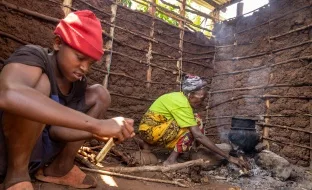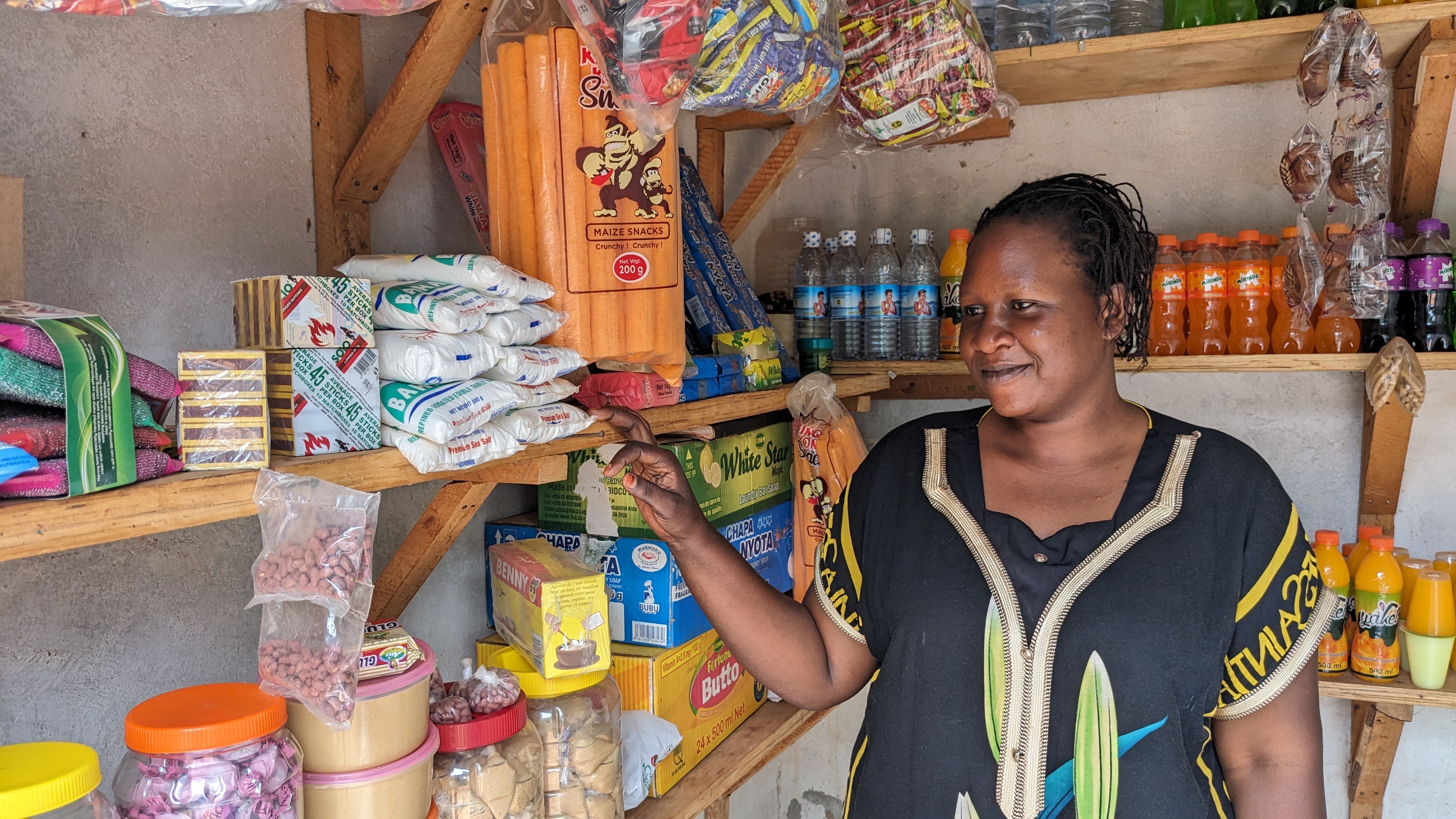- GiveDirectly is partnering with the governments of Malawi and Rwanda to run cash transfer programs integrated with both countries’ wider development plans.
- Taken together, 125,000+ people in extreme poverty will receive ~$550 with no strings attached – Africa’s biggest large lump sum cash aid programs ever.
- These programs create a path to accelerating the end of extreme poverty through cash transfers in both countries
Partnering with government increases the impact of your donation
GiveDirectly’s role as a non-profit is to innovate in how cash aid is delivered and study the impact. National governments are central to alleviating poverty in their countries, and any effective non-profit should be working in concert with them.
GiveDirectly has launched our largest collaborations with national governments in Malawi and Rwanda. By partnering with these countries, we can now work district-by-district rather than village-by-village, delivering life-changing cash to thousands of communities and building towards a national scale.
Working with national governments improves our operations:
- Helping people at this scale is only possible with close coordination (e.g., integrating with social registries to get more accurate data).
- It allows us to combine GiveDirectly donor support with national development budgets to deliver more unconditional cash than we would otherwise.
- We maximize the impact of cash assistance by pairing it with independently-planned improvements to clinics, roads, and schools.
- We exchange best practices and lessons as we look to run even large programs.
GiveDirectly’s fundamentals do not change when working with governments:
- We are recipients first, prioritizing their preferences over those of donors, governments, or ourselves.
- Recipients are selected based on need, without bias for ethnicity, religion, political affiliation, sexual orientation, age, or disability.
- We still handle and deliver all funds to recipients without intermediaries.
- The cash is given unconditionally, with no strings attached.
We’re giving ~$550 to 125,000+ people in Malawi & Rwanda with government support
In Malawi…
Poverty has not fallen despite significant investment
- Despite decades of peace and security, today Malawi is the world’s poorest peaceful country with a GDP per person of just $645, half of that of neighboring Tanzania and Zambia. Two of every three Malawians live in extreme poverty.
- Since 2005, wealthy countries have spent $16.5B in development assistance to Malawi, yet poverty has not decreased, in part because many families are simply too poor to take advantage of new investments like schools and clinics. New ideas are needed to jumpstart the country’s escape from poverty.
GiveDirectly will deliver $550 to every adult in an entire sub-district
- All ~73,000 adults in a sub-district in Lilongwe Rural will receive $550 each by August this year, funded by the Canva Foundation and GiveDirectly donors. How do they spend it? Watch here→
- This creates sustainable impact. Existing research on our Malawi program found recipients were more food secure and more resilient to shocks 2 years after payment. A recent study from a similar program in Kenya found improvements to income, savings, child health, education, and domestic violence 2 years on.
- We’ll generate evidence on the inflation impacts of delivering cash at this scale and how cash supports escape from poverty.
This work aligns with Malawi’s Wealth Creation Project and digital infrastructure investments
- Malawi’s project aims to catalyze and sustain inclusive wealth creation and self-reliance by using cash transfers to complement other development investments in economic and social infrastructure. The overall Malawi 2063 wealth creation agenda aims to reduce poverty and create a conducive environment for private sector development.
- Additionally, over 5,000 residents will receive their first government IDs – a requirement to enroll for mobile money payments – in coordination with the National Registration Bureau.
- We’re also helping make their digital beneficiary registration database more dynamic, adding real-time information about participation in social protection programs. We’re also piloting new ways of collecting data on recipients’ poverty status to further build this database using machine learning.
In Rwanda…
Economic growth has helped many escape poverty, but more can be done
- Over the past three decades, Rwanda’s GDP has grown by 5-10% annually and the government has invested in education and healthcare, providing subsidies to make them widely accessible.
- Rwanda’s consistent progress in reducing poverty is impressive, yet its Human Development Index ranking at 165th of 191 countries highlights the potential for further development.
- More can be done to ensure national economic gains reach the poorest. The more families accessing the benefits of an improving country, the more economic contribution will be recorded, thereby bridging this gap and accelerating the end of extreme poverty in Rwanda.
GiveDirectly will deliver ~$550 to 53,000+ people
- ~53,250 adults across 5 sub-districts (sectors) will receive ~$5501 by the end of this year, with the support of the Rwandan Government. What do they spend it on? Watch here→
- This creates sustainable impact. Existing research on our Rwanda programs found recipients used their funds to significantly increase their incomes, savings, assets, productive hours, home values, nutrition, and consumption, along with a decrease in child mortality.
This work aligns with Rwanda’s Sustainable Graduation program
- Rwanda’s National Strategy for Sustainable Graduation aims to help all households below the poverty line to achieve sustainable livelihoods. Their program combines cash transfers with socio-economic services and training to help people permanently escape poverty.
- We are also providing a technical assessment of eKash, Rwanda’s national digital payment infrastructure, to improve the government’s aid delivery systems.
This is a bold step towards accelerating the end of extreme poverty in both countries
By investing in large lump sum transfers, Malawi and Rwanda are making evidence-based policy. Research shows delivering money as a large lump sum (~$500 at once) improves incomes and self-reliance significantly because people in poverty need the capital to invest in themselves. While many African countries give small cash payments (~$10 per month) through social welfare programs, supplementing these with large lump sums to enable investment is exceedingly rare.
With these governments, GiveDirectly is demonstrating what it takes operationally to work at scale, creating an administrative know-how to serve the bigger vision: delivering large cash transfers nationwide. Combined with each country’s respective development plans, we expect these efforts to significantly and sustainably reduce poverty. This, in turn, can create a roadmap for how to accelerate the end of extreme poverty worldwide.
Additional resources
Accelerating the end of extreme poverty
- Op-ed: A Global Cash-Transfer Fund Could End Extreme Poverty + concept note
- Op-ed: Give more money directly to end extreme poverty
- Op-ed: Cash transfers should be the default, not just the benchmark
Malawi project
- GiveDirectly Malawi: Past & present programs info
- President of Malawi: Meeting with GiveDirectly leadership
- Canva: Uplifting people from extreme poverty: the next step in our journey with GiveDirectly
Rwanda project
- GiveDirectly Rwanda Past & present programs info
- President of Rwanda: Meeting with GiveDirectly leadership
- New Times: Rwanda, GiveDirectly to strengthen partnership in poverty reduction
- New Times: Can Rwanda evolve into a poverty-free country? GiveDirectly’s mission to accelerate poverty reduction in Rwanda
FAQs
Why ~$550 per person?
The transfer size is based on two primary factors:
- an estimation of the average poverty gap per person in extreme poverty (i.e how far most people are from crossing the extreme poverty line).
- existing research evidence showing this amount as a one-off transfer has significant impacts on wealth creation and self-reliance, while more money may have diminishing returns. More→
Rather than give a fixed amount per household, giving to individual adults is more responsive to variances in household sizes, which often include adult children living with parents. Our analysis of these projects will help clarify if this transfer size and method is optimal for helping recipients escape poverty.
Extreme poverty has been dropping; won’t it just solve itself over time?
The short answer is no; the world is on track to still have over half a billion people in extreme poverty by 2030, the vast majority in sub-Saharan Africa.
Economic growth alone will not solve this problem, as extreme poverty persists even in countries with basic public goods (e.g. healthcare access, functioning roads and markets) and reliable institutions. Take Rwanda as an example: for the last 3 decades, the GDP has grown by 5-10% annually. Government-subsidized education and healthcare is widely available. But poverty reduction efforts have not been as successful as hoped, slowing the country’s growth. Rwandans in extreme poverty often find it difficult to access opportunities that surround them.
Cash transfers are the boost many households need to become self-reliant. Even China, a runaway success for using economic growth to reduce poverty, is using cash transfers to bring the final ~1% of their population out of extreme poverty.
Is eradicating extreme poverty a reasonable goal?
With global coordination, yes. Poverty in Latin America and Asia dropped significantly in the past 30 years, partly thanks to extensive cash assistance programs. However, the number of Africans in extreme poverty is nearly unchanged, and one in every five people faces hunger.
Each year that global wealth grows, it becomes all the more unreasonable that we have not finished the job. That’s why the United Nation’s number one goal is to “eradicate extreme poverty for all people everywhere.”
Shouldn’t we instead be investing in developing some breakthrough technology or medicine?
The world is eager for breakthroughs like a new vaccine or technology that both works and can be quickly and widely adopted. Cash transfers are that breakthrough.
This one intervention can improve dozens of important outcomes at once. With over 1000 studies and counting, it’s been proven effective, adaptable, and replicable. Every year as mobile coverage grows and technologies improve, the case for cash transfers becomes more undeniable. While some consider direct cash transfers “the thing to beat,” we believe they are the thing to scale.
Cash transfers are uniquely effective at improving multidimensional poverty. While addressing diseases like malaria or river-blindness would reduce suffering, they are only endemic in some but not all places with high extreme poverty – in 2020, malaria impacted about a third of people in extreme poverty. R&D to find other ways of helping is valuable, but not at the cost of scaling what we know works to help the most people suffering today.
GiveDirectly is a nonprofit that lets donors send money directly to the world’s poorest, no strings attached. In the last decade, we’ve delivered $700M+ to over 1.5 million people and run programs in partnership with the governments of Bangladesh, the DRC, Kenya, Liberia, Malawi, Morocco, Rwanda, Uganda, & the U.S.
Footnotes
- Every eligible household receives $1,100, delivered to the head of the household. Beyond that, any additional young adults (21-35 year olds) within that household receive $550. Any additional young mothers (moms under 21 years old) also receive $550.

